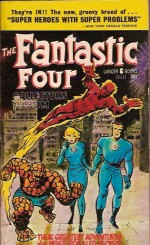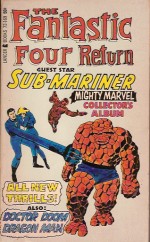

By Stan Lee, Jack Kirby & various (Lancer)
“ISBNs†72-111 and 72-169
Here’s a final brace of Swinging Sixties “Pop-Art†compendia celebrating the meteoric rise of the Little House that Stan, Jack and Steve Built, which will probably be of interest only to inky-fingered nostalgics, fan fanatics collectors and historical obsessive pickers, but as I’m all of them and it’s my party:
Far more than a writer or Editor; Stan Lee was also a master of entrepreneurial publicity generation and his tireless schmoozing and exhaustive attention-seeking was as crucial as the actual characters and stories in promoting his burgeoning line of superstars.
In the 1960s most adults, especially many of the professionals who worked in the field, considered comic-books a ghetto. Some disguised their identities whilst others were “just there until they caught a breakâ€. Stan and creative lynchpins Jack Kirby and Steve Ditko had another idea – change the perception.
Whilst Kirby and Ditko pursued their respective creative credos and craft, waiting for the quality of the work to be noticed, Stan pursued every opportunity to break down the ghetto walls: college lecture tours, animated shows (of frankly dubious quality at the start, but always improving), foreign franchising and of course getting their product onto mainstream bookshelves in real book shops.
There had been a revolution in popular fiction during the 1950s with a huge expansion of affordable paperback books, and companies developed extensive genre niche-markets, such as war, western, romance, science-fiction and fantasy.
Always hungry for more product for their cheap ubiquitous lines, many old novels and short stories collections were republished, introducing new generations to fantastic pulp authors like Robert E. Howard, Otis Adelbert Kline, H.P. Lovecraft, August Derleth and many others.
In 1955, spurred on by the huge parallel success of cartoon and gag book collections, Bill Gaines began releasing paperback compendiums culling the best strips and features from his landmark humour magazine Mad, and comics’ Silver Age was mirrored in popular publishing by an insatiable hunger for escapist fantasy fiction.
In 1964 Bantam Books began reprinting the earliest pulp adventures of Doc Savage, triggering a revival of pulp prose superheroes, and seemed the ideal partner when Marvel began a short-lived attempt to “novelise†their comicbook stable with The Avengers Battle the Earth-Wrecker and Captain America in the Great Gold Steal.
Although growing commercially by leaps and bounds, Marvel in the early 1960s was still hampered by a crippling distribution deal limiting the company to 16 titles (which would curtail their output until 1968), so each new comicbook had to fill the revenue-generating slot (however small) of an existing title. Even though the costumed characters were selling well, each new title would limit the company’s breadth of genres (horror, western, war, etc) and comics were still a very broad field at that time. It was putting a lot of eggs in one basket and superheroes had failed twice before for Marvel.
As Lee cautiously replaced a spectrum of genre titles and specialised in superheroes, a most fortunate event occurred with the advent of the Batman TV show in January 1966. Almost overnight the world went costumed-hero crazy and many publishers repackaged their old comics stories in cheap and cheerful, digest-sized monochrome paperbacks, and it’s easy to assume that Marvel’s resized book collections were just another company cash-cow, part of their perennial “flood the marketplace†sales strategy, but it’s just not true.
Lee’s deal with Lancer to publish selected adventures in handy paperback editions had begun a year earlier with The Fantastic Four Collectors Album. Other comics publishers – National/DC, Tower Comics and Archie – were just as keen to add some credibility and even literary legitimacy to their efforts, but were caught playing catch-up in the fresh new marketplace. Moreover, when Lancer began releasing Marvel’s Mightiest in potent and portable little collections it was simple to negotiate British iterations of those editions.
Except for the FF – as far as I can ascertain neither of the books on display here ever had a UK edition.
A word about artwork here: modern comics are almost universally full-coloured in Britain and America, but for over a century black and white was the only real choice for most mass market publishers – additional (colour) plates being just too expensive for shoe-string operations to indulge in. Even the colour of 1960s comics was cheap, and primitive and solid black line, expertly applied by master artists, was the very life-force of sequential narrative.
These days computer enhanced art can hide a multitude of weaknesses – if not actual pictorial sins – but back then companies lived or died on the illustrating skills of their artists: so even in basic black and white (and the printing of paperbacks was as basic as the accountants and bean-counters could get it) the Kirbys and Ditkos of the industry exploded out of those little pages and electrified the readership.
I can’t see that happening with many modern artists deprived of their slick paper and multi-million hued colour palettes…
This first stellar volume from the utterly on-form Lee, Kirby & Dick Ayers opened with a couple of second appearances as the deadly Doctor Doom allied with a reluctant but gullible Sub-Mariner to attack our quirky quartet in ‘Captives of the Deadly Duo!’ (FF #6, 1962)
In this first Marvel super-villain team up Prince Namor‘s growing affection for the team’s female member forced the sub-sea stalwart to save his foes from dire death in outer space – but only after Doom tried to kill him too…
That superb classic was actually split into two sections and interrupted by a quick recap of the origin, cobbled together from #1 and #11…
The Fantastic Four saw maverick scientist Reed Richards summon his girl-friend Sue Storm, their friend Ben Grimm and Sue’s teenaged brother Johnny before heading off on their first mission. In a flashback we discover they are driven survivors of a private space-shot which went horribly wrong when Cosmic Rays penetrated their ship’s inadequate shielding. They crashed back to Earth where they found that they’d all been hideously mutated into outlandish freaks…
Richards’ body became elastic, Sue gained the power to turn invisible, Johnny Storm could turn into living flame and tragic Ben turned into a shambling, rocky freak. Shaken but unbowed they vow to dedicate their new abilities to benefiting mankind…
After a series of stunning solo pin-ups by Kirby & Joe Sinnott, ‘The Impossible Man’ also from #11 (February 1963) followed; depicting a bizarre, baddie-free yet compellingly light-hearted tale about a fun-seeking but obnoxiously omnipotent visitor from the stars who only wants to have fun, and could only be “defeated†by boredom…
Following Super Skrull and Molecule Man pin-ups, ‘The Mad Menace of the Macabre Mole Man!’ (Lee, Kirby & Chic Stone from issue #31, October 1964) saw the uncanny underground outcast try once more to conquer the surface world in a stunning tale which balanced a loopy plan to steal entire streets of New York City with a portentous sub-plot featuring a mysterious man from Sue’s past. Presumably to avoid confusion a rather fractious spat over jurisdiction with the Mighty Avengers was excised from this edition…
To complete the graphic wonderment this initial outing ends with pin-ups of the Hate Monger and the dastardly Diablo as well as a house ad for the burgeoning Marvel Comics Line…
The Fantastic Four Return (Guest Star Sub-Mariner) was the penultimate Marvel/Lancer edition, released in 1967 and opening with ‘The Final Victory of Dr. Doom!’ from Fantastic Four Annual #2 (1964, by Lee, Kirby & Stone) and saw the mysterious monarch of Latveria brazenly attack the quartet only to suffer his most galling defeat, after which ‘Side-by-Side with Sub-Mariner!’ brought the aquatic anti-hero one step closer to his own series when the team lent surreptitious aid to the embattled undersea monarch against the hordes of deadly sub-sea barbarian Attuma in a blistering battle yarn by Lee, Kirby & Stone from FF #33 (December 1964).
‘Calamity on the Campus!’ (FF #35 February 1965 by the same creative team) saw the heroes visit Reed Richard’s old Alma Mater in a tale designed to pander to the burgeoning college fan-base Marvel was cultivating, but the rousing yarn that brought back Diablo and introduced the monstrous homunculus Dragon Man easily stands up as a classic on its own merits, full of spectacular action and even advancing the moribund romance between Reed and Sue to the point that he would actually propose in the months to come…
This superb book only boasts one pin-up but it is a classic shot of the mighty and regal Sub-Mariner by Kirby & Stone…
As someone who bought these stories in most of the available formats over the years – including the constantly recycled reprints in British weeklies from the mid-sixties to the 1980s – I have to admit that the classy classic paperback editions have a charm and attraction all their own even if they are heavily edited and abridged and rather disturbingly printed in both portrait and landscape format…
If you’ve not read these tales before then there are certainly better places to do so (such as the pertinent Essential or Marvel Masterwork volumes) but even with all the archaic and just plain dumb bits these books are still fabulous super-hero sagas with beautiful art that will never stale or wither, and for us backward-looking Baby-boomers these nostalgic pocket tomes have an incomprehensible allure that logic just can’t tarnish or taint…
© 1966 and 1967 Marvel Comics Group. All rights reserved.
